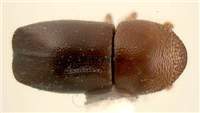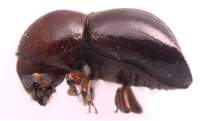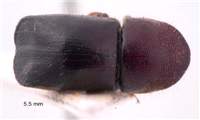Diagnosis
Large to very large and bulky. Elytral disc strongly convex ("humped"), elytral declivity distinctly flattened and broadened posterolaterally. Posterolateral declivital costa ends in 5th interstriae (unique).
Similar to Fortiborus, but declivity devoid of tubercles, anterior edge of pronotum with continuous elevated carina.
Distribution
Asia and Australasia, mostly tropical.
Biology
Short galleries, randomly branching, with rich growth of symbiotic fungi. Frequently followed by fungus-stealing mycocleptic species of Ambrosiophilus.
Taxonomy
Relationships unclear. Only recently described genus, most species formerly included in Xyleborus.
Detailed description
Eyes deeply emarginate to almost disjunct, upper portion of eyes as large as lower part or larger. Antennal club approximately circular, type 3 (with segment 1 straight or convex), or four (segment 1 small, second and third prominent on both sides). Margin of segment 1 of club approximately straight on anterior face, or convex and small, mostly costate, may appear softer on club margins. Segment 2 variable: visible on both sides of club and soft, or with corneous part on anterior side, or corneous on both sides of club and sinuate, not circular. Segment 3 clearly visible on both sides of club. Segment 1 of antennal funicle shorter than pedicel, sometimes longer than pedicel with its base stalk-like. Funicle 4-segmented, scapus regularly thick. Frons above epistoma rugged, coarsely punctate. Submentum slightly impressed, shaped as very narrow triangle. Anterior edge of pronotum usually with short continuous elevated recurved carina, blunt in one species. Pronotum from lateral view tall (type 2), or rounded and robust (type 5), from dorsal view conical (type 0), or rounded (type 1), subquadrate in one species (type 3). Pronotal disc densely and evenly punctured, often with asperities resembling those on frontal slope, lateral edge of pronotum obliquely costate, often with distinctly elevated shoulder. Procoxae contiguous, prosternal posterocoxal process short and conical, or flat and inconspicuous, or conical and slightly inflated. No signs of mesosternal or elytral mycangia or associated setae. Scutellum flat, flush with elytra. Elytral bases straight, with oblique edge, elytral disc longer than or equally long as declivity and usually convex, rarely impressed, "saddle-like". Punctures on elytral disc in strial lines, confused on declivity. Lateral profile of elytral declivity slowly descending or steep, flat or excavated, dorsal profile of elytral apex broadened laterally, often shallowly emarginate. Elytral declivity with few setae or scales, not conspicuously pubescent. Posterolateral declivital costa ends in 5th interstriae, an autapomorphy of the genus. Inner part of declivity with no tubercles, or small uniform granules. First interstriae parallel. Protibiae obliquely triangular, broadest at 2/3 of length, or distinctly triangular, slender on upper part, broad and denticulate on lower part. Posterior side of protibia flat, no granules, only setae. Protibial denticles rarely small, mostly large and distinctly longer than wide, bases of denticles slightly elevated to distinctly enlarged, conical, usually between 6 and 8 protibial denticles present. Large to very large species, robust, 3.8-7.5 mm. Mostly uniformly dark brown or black, pronotum sometimes lighter, interstriae on elytra often reddish.



